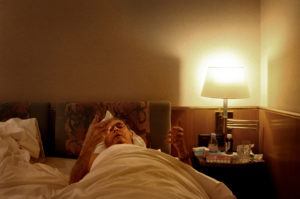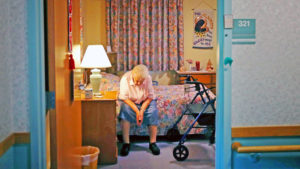With uncharacteristic humility, I would concede that a few positions I’ve argued fiercely in print might be viable on paper, but in practice are a disaster. The “war on drugs” being a fiasco, years ago I advocated the legalisation of recreational pharmaceuticals. But given the dirty, dangerous, dismal tent cities full of addicts in LA, San Francisco, Seattle, and Portland — which have all effectively decriminalised drug possession — it may be fortunate that glib journalists like me don’t control public policy.
I’ve likewise argued for legalised assisted dying. After all, nobody asked us if we wanted to be here (a favourite headline: “Woman Sues for Being Born”); the least we might expect is help leaving the building. Why should living be an obligation? While the strongest candidates for a gentle, legal assisted death are patients with agonising terminal illnesses, any respectable libertarian would maintain that outfits such as Dignitas in Switzerland simply provide a service, of which consumers in any medical condition should be free to avail themselves. And for lack of a better word, I’m a libertarian.
I gained an appreciation for how being alive could simply fail a clinical cost-benefit analysis in the summer of 2020. For five days, I was in such blinding pain from a nerve in my spine that I awoke each morning screaming at my poor husband: “I would rather be dead!” I wasn’t being histrionic. Well, okay, I was — but I was also brutally sincere. Had remaining alive been conditioned on such intense and unrelenting suffering forever more, for the first time I could see a persuasive case for calling it quits. During the blackest periods of those days, on which I took half an hour to descend a single flight of stairs, I was incapable of pleasure, humour, or love. The sole thought in my head was that I would do anything to get the pain to stop.
Canada has an unusually liberal programme called Medical Assistance in Dying, or Maid — although this acronym doesn’t tidy your flat but sponges your existence from the known universe. The Great White North should, therefore, represent my perverse version of Valhalla. Instead, Maid’s lax protocols make me queasy. In theory, maybe everyone has a right to die if they want to. In practice, maybe the state needs to keep a tight regulatory reign on whom it graciously provides a one-way ticket to nowhere.
Introduced in 2016, Canada’s government-sanctioned euthanasia by medically administered lethal injection and legalisation of assisted suicide (there’s a difference; the latter usually entails patients themselves swallowing fatal tablets prescribed by a doctor) were initially intended to put the terminally ill who’d had enough out of their misery. Yet sister programmes in the seven other countries that permit euthanasia generally restrict the pool of applicants to people destined to die naturally within six months. Maid initially codified no such limitation, merely citing vaguely that death should be “reasonably foreseeable”, as it is for all us mortals. Hypothetically, then, even the programme as originally conceived could have been open to people whose ailments would only kill them many years hence. Yet, bolstering its critics’ “slippery slope” argument, the programme soon radically loosened its restrictions. Assisted dying is now available in Canada to all adults with a serious illness or disability, regardless of whether the source of their torment would be fatal over time.
Most controversially, the government is considering the offer of lethal injection to “mature minors” — whatever that means. The programme is also set to extend to Canadians who are mentally ill. That said, the start date of state-sponsored death for the psychologically unwell (which on one day or another would probably include us all) has been pushed back to March 2024, indicating a degree of bureaucratic anxiety.
Given the stories in the press, that anxiety may be warranted.
At the age of 61, Alan Nichols had a history of depression and was hospitalised as a suicide risk in 2019 — something of an irony, as in due course the hospital staff, according to his family, was altogether too helpful in facilitating the patient’s application for euthanasia. That application was accepted, even though the only health condition it cited as so intolerable that Nichols wanted to die was “hearing loss”. After Nichols was put to death, his family objected that the man was not suffering unbearably, had been refusing to take his medication, and wouldn’t use the cochlear implant that helped him hear. But no medical personnel had ever contacted his relatives, out of respect for patient confidentiality.
While some Canadian disability advocates are upset that disability alone is now a qualification for euthanasia, arguably sending a social signal that the disabled are a burden and better off dead, Nichols did not nominate himself as a political representative of any group. He was just one person who didn’t want to be here anymore, and if we’re not impressed by his motives, that’s our problem. Whether or not to head for the back door was his decision, his business.
Still — I’m reaching here. Hearing loss? Really?
Suffering from Lou Gehrig’s disease at 41, Sean Tagert required 24-hour care, but British Columbia only provided 16-hour assistance. Paying caretakers for the remaining eight hours cost Tagert CA$264 per day. Health authorities did offer to move Tagert to an institution, but its location was far from the young son who was clearly his father’s prime reason for living, as Tagert described such a separation as a “death sentence”. The man managed to raise CA$16,000 to invest in medical equipment that would allow him to remain at home, but the funds were insufficient. So instead he applied for euthanasia. The end.
All health systems have finite resources, so let’s assume that 16-hour care was all British Columbia could afford. If Tagert couldn’t manage on that support, we wouldn’t encourage a bureaucracy to give in to blackmail: If you don’t give me 24-hour care, I’ll kill myself. On the other hand, the availability of assisted dying as a solution to his problems must have made it more likely that Tagert would choose death, as opposed to giving institutional care a go and perhaps discovering that seeing his son somewhat less often wasn’t the end of the world. In general, then, legalising assisted dying without fierce limits on who qualifies may increase the likelihood that, rather than find more creative escapes from their predicaments, people give into despair.
In more than one instance in Canada, too, patients seem to have been actively pressed to consider pulling their own plug to save the health system money. Hospitalised for a degenerative brain disorder, Roger Foley was, according to Associated Press, “so alarmed by staffers mentioning euthanasia that he began secretly recording some of their conversations”. In one recording, the hospital’s director of ethics informs Foley that his hospital stay is costing the institution “north of $1,500 a day” — quite the guilt trip. Foley asks about the plan for his long-term care. “Roger, this is not my show,” the “ethicist” said. “My piece of this was to talk to you, to see if you had an interest in assisted dying.” But Foley himself had never expressed the slightest interest in dying.
For while the Australian province of Victoria, for example, forbids doctors from bringing up the option of euthanasia, lest it be mistaken for medical advice, Canada’s physicians can cheerfully recommend being killed as one of patients’ “clinical care options”. Thus, Sheila Elson took her daughter to an emergency room in Newfoundland six years ago. Unprompted, the doctor informed Elson that her daughter of 25, who had cerebral palsy and spinal bifida, was a good candidate for euthanasia. As Elson later told the Canadian Broadcasting Corporation, the doctor chided that not taking up the state’s kindly offer to slay her daughter would be “selfish”.
Given that they both tattled to the media, Foley and Elson clearly resented being enticed to please consider lethal injection as an economy for the state. But more fragile characters might be less apt to stand up for their rights.
At least four cases have been unearthed of veterans with, say, PTSD being encouraged to consider assisted dying in preference, as one staffer put it diplomatically, to “blowing your brains out”. Maid has been active in prisons as well, whose population is also costly and understandably prone to feeling glum. I wouldn’t melodramatically portray this programme as some wicked Final Solution for castoffs and criminals, but there’s more than a hint here of the brutal social utilitarianism that horrified Captain Kirk in more than one episode of Star Trek.
The woman who has most alarmed critics of Maid’s prospective extension to the mentally ill is Lisa Pauli, who is queueing up for assisted dying months in advance. At 47, Pauli has been anorexic for the better part of 40 years and now holds out no hope of defeating the disorder. She weighs 92 pounds and goes days without solid food. Pauli’s psychiatrist assures her that once the law in Canada becomes more encompassing next year, she’ll probably be eligible for assisted dying. Yet it takes one look at Lisa Pauli’s picture to conclude that she doesn’t need a lethal injection. She needs a sandwich.
Maid is popular in Canada. In a recent Research Co. poll, 73% of Canadians approved of the regime in its current form, while only 16% opposed it. Moreover, a goodly measure of Canadians would be happy for the programme to expand further: 27% claimed Maid should be an option even for people whose only affliction was “poverty”; 28% would offer state-sponsored oblivion to the homeless. A fifth of respondents would provide Maid to anybody for any reason. Sean Tagert’s was one of several cases of Canadians finally choosing death after years of struggling to obtain sufficient health care, and a hefty 51% of poll respondents believed that “inability to receive medical treatment” should qualify applicants for the needle.
I wonder if these Canadians are exercising their imaginations. For governments, citizens are an annoyance. Is it really in the broader interest of us peons to make it too easy for the authorities to simply dispose of us, rather than contend with our messy, expensive problems? Keep loosening the restrictions on such programmes, and pretty soon it’s only so fanciful to envision California cleaning up its tented encampments of homeless alcoholics and drug addicts by sending Swat teams marching through the cardboard and corrugated iron with sub-machine guns.
As for qualifying for euthanasia by dint of mental illness, psychic afflictions are still poorly understood and poorly defined. Because the portion of the population claiming to have mental health problems continues to rise, this is surely the gateway to offering the ultimate cure for human suffering to everybody. Although all pain is subjective, the physical kind usually has an objective correlative. In 2020, I could have shown you on an MRI exactly what was wrong with my back. Mental pain, though, is heavily dependent on self-reporting, so that assessing its severity from the outside is almost impossible.
While Maid guidelines stipulate that whatever drives a candidate to seek a last resort should be incurable, it’s also impossible to tell whether mental problems are temporary or intransigent. In fact, one of the major concerns of too-ready access to assisted dying is that people are moody, fickle, and changeable. One day, one month, or even one year, our outlook can be unbearably bleak, and the challenges of the future can appear insurmountable. But fortunes and frames of mind can pick up, clouds lift: we get a new job, fall in love, finally put a bereavement behind us, after which the prospect of asking to die may strike us as preposterous. Many a failed suicide has been grateful in retrospect for having botched the job.
What’s especially puzzling about Canada, of all places, having such loose restrictions on assisted dying is that Justin Trudeau’s government is famously — I would say notoriously — Left-wing. It’s the Left that traditionally prides itself on concern for the “vulnerable” (a ubiquitous catch-all adjective I’ve come to detest). We would expect Canadian worthies to be out on the streets protesting the state’s offer of nonexistence to the incapacitated, the incarcerated, the addled, or the down at the heel, and instead a slim majority of the country seems to see assisted dying as an answer to the shortcomings of their healthcare system. In a way, I’m impressed. I didn’t think those wet Canadians capable of such cool, callous calculation.
To be fair, the average age of Canadians euthanised by Maid in 2021 was 76; 80% had already been in palliative care, and 65% had cancer. In majority, the regime continues to serve the patients it was originally designed to help: people in searing physical pain who are certain to die soon anyway.
I come full circle, then. I still believe in legal assisted dying. After that experience of paralysing nerve pain — which has blessedly not returned — I would even endorse extending such a service to people in non-fatal agony if such life-despoiling torture is chronic and physicians can offer no effective relief. But that’s where I’d draw the line, and I’d hold the line: relieving people of physical pain, for which I have developed a sober respect.
Ironically, the very liberality of Canada’s system has turned it into a political weapon for opponents of kindred programmes proposed in countries such as Britain, where the practice of assisted dying is still banned. But there’s no reason a state that allows what used to be called “mercy killing” under strictly defined circumstances necessarily slides down that hackneyed slippery slope and starts slaughtering every citizen whom someone considers inconvenient or costly. A well-designed protocol should require a waiting period and make it easy for clients to change their minds. Knowing they have the option of an ultimate exit gives many people the fortitude to keep going.
If I would not offer legal euthanasia to anorexics, people with hearing loss, or depressives, much less to the poor or homeless, let’s remember what’s at issue: not whether the state forces you to keep living but whether the state actively helps you die. For any folks bound and determined to not be here anymore, a range of old-fashioned if unpleasant remedies remain at hand. If that disagreeableness presents enough of a barrier to get you to reconsider, maybe you’re still up for continuing to kick around the planet after all.
Disclaimer
Some of the posts we share are controversial and we do not necessarily agree with them in the whole extend. Sometimes we agree with the content or part of it but we do not agree with the narration or language. Nevertheless we find them somehow interesting, valuable and/or informative or we share them, because we strongly believe in freedom of speech, free press and journalism. We strongly encourage you to have a critical approach to all the content, do your own research and analysis to build your own opinion.
We would be glad to have your feedback.
Source: UnHerd Read the original article here: https://unherd.com/





